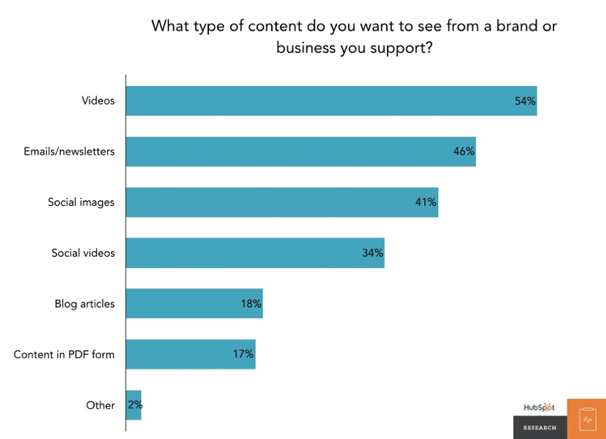Regardless of platform, video has become the most popular type of digital content among consumers. It has also moved to the forefront of most marketing strategies, as it balances the advancement of technology with an unlimited expanse of creativity.
According to a report from HubSpot Research, 54% of consumers want to see videos from brands they support in comparison to email newsletters (46%) or social image content (41%). Additionally, the report states that video is the most memorable content (43%) in comparison to images (36%) and text (18%).
The research is clear that producing video content is critical, but in an ever-evolving digital landscape, it can be difficult to understand all of the options. Below, we outline four trends worth paying attention to and how they can be used.
1. Live Video on Social Media
Between Facebook Live, YouTube Live, and live streaming mobile apps like Periscope, the opportunities for live video are wide enough to customize your desired experience to a specific platform. Live video also draws people in for longer segments of time, as consumers tend to spend 3x longer watching live videos than they do pre-recorded content. The same study showed that 82% of consumers prefer live videos over other types of social posts, which gives you the opportunity to connect and engage with new audiences.
Audience engagement is one of the most beneficial features of live video, as the video host is able to react and respond to the audience in real-time “on-air” and video viewers are able to interact with one another through the comment stream. Live video is also a good opportunity to tailor your company’s Story and brand to the context of your platform and reinforce that what you’re offering connects with your consumers.
2. 360-Degree Video
360-degree video is exactly what it sounds like: a video that offers multidimensional, changing perspectives to display something at all angles. This unique perspective provides a customized experience for viewers, without necessarily making production more difficult for the videographer and video host.
For example, Sotheby’s International Realty has been using 360-degree video to sell more homes. The use of omnidirectional cameras suggests a spherical video that allows viewers to fully emerge themselves in the experience. Home buyers can see every angle of the property by taking a virtual walkthrough tour – saving buyers and real estate agents’ time, and helping the Sotheby’s brand stand out from the rest.
3. Virtual Reality (VR)
Virtual Reality (VR) still lingers in uncharted territory for most companies, but global revenue is expected to reach $3.7 billion by 2020. This means it’s time to embrace this rapidly-expanding technology and get ahead of your competitors.
VR is the unique step-sibling of 360-degree video in that it allows the customer to tailor your technology to their own experience and engage with your brand the way they want. Start thinking today about how you can incorporate VR into your Strategy and Systems.
For example, Lowe’s Home Improvement implemented VR to solve a problem for their customers and delight them in the process. Lowe’s took the figure of 70 billion wasted home improvement dollars and set out to solve the problem and save their customers money with the implementation of new technology. The VR apps and in-store tutorials help customers navigate the store, learn DIY skills and visualize their projects from start to finish. Named a 2018 Top 10 Most Innovative Company in AR/VR, Lowe’s Home Improvement is creating disruptive solutions that align with their brand Story.
“Our innovation story connects back to the company’s purpose of helping people love where they live, now and in the future,” said Josh Shabtai, director of Lowe’s Innovation Labs.
4. Video Mapping
Video mapping is a powerful technique that projects designs on a 3D surface, such as the side of a building, a car, or even people. A wide variety of businesses have tied video mapping into their marketing Systems, though the most famous use is arguably Disney’s implementation of video mapping in their fireworks shows. Through creative development and the demand to constantly stay on top of new technology, Disney continues to attract and delight new and returning customers at every touchpoint.
Video mapping is especially helpful to educate consumers at industry events or product launches and anywhere that brands want to captivate an audience. Executed well, video mapping can deliver a memorable experience, helping transform an interested audience into loyal advocators of your brand.
Ultimately, all video content should inform and delight your current client base, while helping attract new customers. People are already prepared to jump through the screen, and new technologies are allowing them to do just that.
Here are some questions to ask yourself to determine what type of video marketing will best suit your needs:
• What are you going to do differently than your competition?
• What new tools do you want to try that will enhance your Story, Strategy, and Systems?
• What video techniques would best align with your Story, Systems, and Strategy?
Video Marketing is one of the most effective business communication tools just waiting to be used to its fullest potential. Forging ahead in the world of video technology and executing it well is a surefire way to head down the road to video marketing success.
